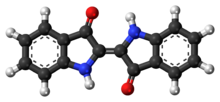Indigo dye
 |
|
 |
|
 |
|
| Names | |
|---|---|
| Other names
2,2'-Bis(2,3-dihydro-3- oxoindolyliden), Indigotin
|
|
| Identifiers | |
|
482-89-3 |
|
| 3D model (Jmol) | Interactive image |
| ChEMBL |
ChEMBL599552 |
| ChemSpider |
4477009 |
| ECHA InfoCard | 100.006.898 |
| RTECS number | DU2988400 |
| UNII |
1G5BK41P4F |
|
|
|
|
| Properties | |
| C16H10N2O2 | |
| Molar mass | 262.27 g/mol |
| Appearance | dark blue crystalline powder |
| Density | 1.199 g/cm3 |
| Melting point | 390 to 392 °C (734 to 738 °F; 663 to 665 K) |
| Boiling point | decomposes |
| 990 µg/L (at 25 °C) | |
| Hazards | |
|
EU classification (DSD)
|
207-586-9 |
| R-phrases | R36/37/38 |
| S-phrases | S26-S36 |
| Related compounds | |
|
Related compounds
|
Indoxyl Tyrian purple Indican |
|
Except where otherwise noted, data are given for materials in their standard state (at 25 °C [77 °F], 100 kPa).
|
|
|
|
|
| Infobox references | |
Indigo dye is an organic compound with a distinctive blue color (see indigo). Historically, indigo was a natural dye extracted from plants, and this process was important economically because blue dyes were once rare. A large percentage of indigo dye produced today – several thousand tons each year – is synthetic. It is the blue often associated with blue jeans.
The primary use for indigo is as a dye for cotton yarn, which is mainly for the production of denim cloth for blue jeans. On average, a pair of blue jean trousers requires 3–12 g of indigo. Small amounts are used for dyeing wool and silk.
Indigo carmine, or indigo, is an indigo derivative which is also used as a colorant. About 20 thousand tons are produced annually, again mainly for blue jeans. It is also used as a food colorant, and is listed in the United States as FD&C Blue No. 2.
A variety of plants have provided indigo throughout history, but most natural indigo was obtained from those in the genus Indigofera, which are native to the tropics. The primary commercial indigo species in Asia was true indigo (Indigofera tinctoria, also known as I. sumatrana). A common alternative used in the relatively colder subtropical locations such as Japan's Ryukyu Islands and Taiwan is Strobilanthes cusia. Dyer's knotweed (Polygonum tinctorum) was the most important blue dye in East Asia until the arrival of the Indigofera species from the south, which yield more dye. In Central and South America, the species grown is I. suffruticosa (añil). In Europe woad containing the same dye was used for blue-dying. Several plants contain indigo, but low concentrations make them difficult to work with and the color is then more easily tainted by other dye substances, typically leading to a greenish tinge.
...
Wikipedia
